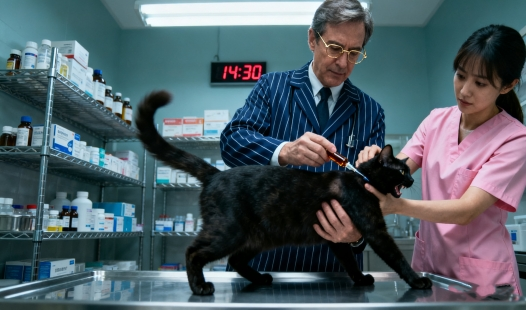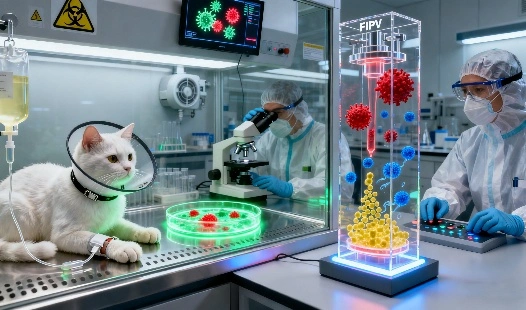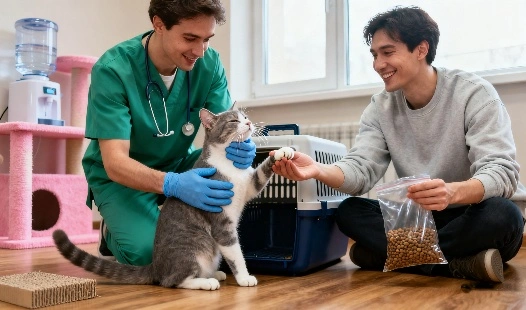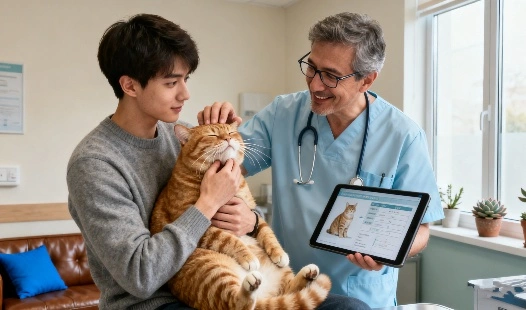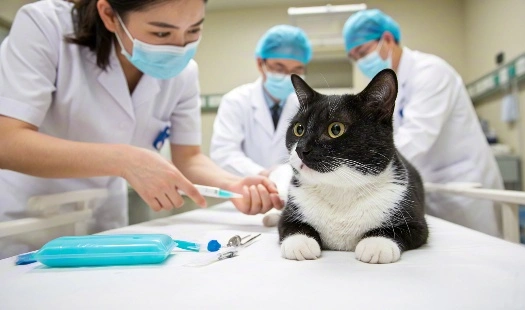Signs your cat is ready to stop GS-441524 treatment
Clinical and Laboratory Markers Indicating Successful GS-441524 Therapy
- Clinical and Laboratory Markers Indicating Successful GS-441524 Therapy
- Establishing Objective Endpoints for GS-441524 Treatment Duration
- The Protocol for Tapering and Discontinuing GS-441524
- Post-Treatment Monitoring After Cessation of GS-441524
- Recognizing the Signs of Sustained Remission Following GS-441524 Therapy
- Conclusion
- FAQ
- Unlock the Potential of GS-441524 with BLOOM TECH
- References
People who own cats have had to deal with Feline Infectious Peritonitis (FIP) for a long time. But the fact that the GS-441524 drug was found to be a possible FIP treatment has given a lot of people hope. It is important to know when your cat might be ready to stop taking their medicine as they get better. You will learn about the main signs that your cat may be ready to stop taking the GS-441524 drug in this article.
 |
 |
 |
Clinical and Laboratory Markers Indicating Successful GS-441524 Therapy
Determining the right time to conclude GS-441524 treatment requires careful observation and analysis of both clinical and laboratory parameters. Veterinarians and researchers have identified several key markers that indicate a successful response to therapy.
Physical Symptoms Improvement
One of the most apparent signs of treatment success is the resolution of physical symptoms. Cats with FIP often experience:
- Weight loss: A significant decrease in body weight is common in cats suffering from FIP. Successful treatment should lead to gradual weight restoration as the cat regains its strength and health.
- Lethargy: Cats with FIP may appear unusually tired, weak, and disinterested in play or interaction. As the treatment takes effect, you should notice a return to their usual energy levels, with increased activity and engagement.
- Poor appetite: FIP often causes a reduced appetite, making it difficult for cats to maintain proper nutrition. As they recover, their appetite should improve, and they should begin eating normally again.
- Fever: Persistent fever is a common symptom of FIP, but with successful treatment, the cat's temperature should return to normal, signaling an improvement in their overall condition.
- Abdominal distension (in wet FIP): In cats with wet FIP, fluid buildup in the abdomen can cause noticeable swelling. As the treatment works, this fluid should gradually be absorbed, and the abdomen will return to a more normal size, reflecting the cat's recovery.
As treatment progresses, these symptoms should gradually improve. A cat ready to stop treatment will typically display:
- Consistent weight gain
- Renewed energy and playfulness
- Normal appetite
- Absence of fever for several weeks
- Resolution of effusion (in wet FIP cases)
Hematological Parameters
Blood work plays a crucial role in assessing treatment efficacy. Key hematological markers include:
- Hematocrit: Should return to normal range (35-50%)
- White Blood Cell Count: Normalization of total and differential counts
- Platelet Count: Return to normal levels (150,000-400,000/µL)
Persistent abnormalities in these parameters may indicate ongoing disease activity and the need for continued treatment.
Biochemical Markers
Serum biochemistry provides valuable insights into organ function and inflammatory status. Important markers include:
- Albumin: Should increase to normal levels (2.5-3.9 g/dL)
- Globulin: Should decrease to normal range (1.5-3.5 g/dL)
- A:G Ratio: Should normalize (>0.8)
- Total Protein: Should return to normal (5.5-7.8 g/dL)
The normalization of these values, particularly the albumin-to-globulin ratio, is a strong indicator of disease remission.
|
|
|
|
Establishing Objective Endpoints for GS-441524 Treatment Duration
While clinical improvement is encouraging, establishing objective endpoints for GS-441524 drug treatment is essential to ensure the best possible outcome for FIP-affected cats. Researchers and veterinarians have proposed several criteria to guide treatment duration decisions.
Minimum Treatment Duration
Current recommendations suggest a minimum treatment duration of 12 weeks for most cases of FIP. This timeframe allows for:
- Complete viral clearance
- Restoration of immune function
- Resolution of organ damage
However, some cats, particularly those with neurological or ocular involvement, may require longer treatment periods.
Sequential Testing Protocol
A sequential testing protocol can help determine readiness to stop treatment:
- Conduct comprehensive blood work at 4-week intervals
- Assess trend of key markers (hematocrit, albumin, globulin, A:G ratio)
- Perform diagnostic imaging (ultrasound, radiographs) to evaluate organ involvement
- Consider advanced testing (e.g., CSF analysis for neurological cases)
Consistent normalization of these parameters over multiple tests increases confidence in treatment success.
Clinical Scoring Systems
Some veterinarians utilize clinical scoring systems to objectively track a cat's progress. These systems typically evaluate:
- Activity level: Monitoring a cat's energy and mobility is crucial. A gradual increase in activity levels, such as returning to normal play or movement, is a positive sign of recovery and indicates that the treatment is working.
- Appetite: Appetite is closely monitored since a lack of interest in food can signal ongoing illness. Improvement in appetite is a key indicator of progress, suggesting the cat is regaining strength and health.
- Weight gain: Cats suffering from FIP often lose weight due to poor appetite and illness. Weight gain during treatment is an essential marker of recovery, indicating the cat is regaining its strength and nutritional status.
- Resolution of specific symptoms (e.g., effusion, ocular signs): The resolution of symptoms such as fluid buildup (effusion) or ocular issues is an important part of tracking progress. As treatment works, these symptoms should gradually improve or resolve entirely, signaling that the disease is under control.
- Laboratory parameters: Blood tests and other lab results are valuable for monitoring the internal status of the cat. These tests can show improvements in inflammation levels, organ function, and other markers of recovery, providing a clearer picture of the cat's overall health.
A consistently low score over several weeks may indicate readiness to discontinue treatment.
|
|
|
|
The Protocol for Tapering and Discontinuing GS-441524
Once your veterinarian determines that your cat is ready to stop GS-441524 drug treatment, a careful tapering protocol is often recommended. This gradual reduction in dosage helps minimize the risk of relapse and allows for close monitoring of the cat's response.
Gradual Dose Reduction
A typical tapering protocol might include:
- Reducing the dose by 25% for 1-2 weeks
- Further reducing to 50% of the original dose for another 1-2 weeks
- Administering the medication every other day for 1-2 weeks
- Complete discontinuation
This gradual approach allows the cat's immune system to adjust and provides an opportunity to detect any early signs of relapse.
Monitoring During Tapering
During the tapering period, close observation is crucial. Monitor for:
- Return of clinical symptoms
- Changes in appetite or activity level
- Weight loss
- Fever
Regular check-ups and blood work during this phase can help detect any concerning trends early.
Post-Treatment Monitoring After Cessation of GS-441524
After completing GS-441524 treatment, ongoing monitoring is essential to ensure sustained remission and detect any potential relapse early. This post-treatment phase is critical for long-term success.
Frequency of Follow-up Visits
A typical post-treatment monitoring schedule might include:
- Weekly check-ups for the first month
- Bi-weekly visits for the second month
- Monthly visits for the next 3-6 months
- Quarterly visits thereafter for at least one year
This schedule allows for timely detection of any concerning changes.
Diagnostic Tests During Follow-up
Follow-up visits should include:
- Physical examination
- Complete blood count (CBC)
- Serum biochemistry panel
- Urinalysis
- Diagnostic imaging as needed (e.g., abdominal ultrasound)
These tests help assess overall health and detect any subtle changes that might indicate a relapse.
Recognizing the Signs of Sustained Remission Following GS-441524 Therapy
Identifying sustained remission is crucial for confirming the success of the GS-441524 drug treatment. Several key indicators suggest that a cat has achieved long-term recovery from fip.
Clinical Markers of Sustained Remission
Signs of sustained remission include:
- Consistent weight gain or maintenance of healthy weight
- Normal activity levels and playfulness
- Excellent appetite
- Absence of fever for extended periods
- No recurrence of effusion or other FIP-specific symptoms
- Good coat quality
These clinical markers, when maintained over several months, provide strong evidence of successful treatment.
Laboratory Indicators of Sustained Remission
Key laboratory parameters indicating sustained remission include:
- Stable hematocrit within normal range
- Normalized white blood cell counts and differentials
- Consistent albumin-to-globulin ratio >0.8
- Normal liver and kidney function tests
- Absence of anemia or thrombocytopenia
Persistent normalization of these values over multiple follow-up visits supports the conclusion of successful treatment.
|
|
|
|
Conclusion
Determining when to stop GS-441524 treatment for FIP requires a comprehensive approach, considering clinical signs, laboratory markers, and individualized patient factors. While the standard 12-week treatment course is often sufficient, some cats may require longer therapy. Close collaboration with your veterinarian, careful monitoring during tapering, and vigilant post-treatment follow-up are crucial for ensuring the best possible outcome for your feline companion. By recognizing the signs of successful treatment and sustained remission, cat owners can navigate the challenging journey of fip treatment with greater confidence and hope.
FAQ
1. How long does GS-441524 treatment typically last for FIP?
The standard treatment duration for GS-441524 in FIP cases is typically 12 weeks. However, this can vary depending on the individual cat's response and the specific form of FIP (e.g., wet, dry, or neurological). Some cats, especially those with neurological involvement, may require longer treatment periods.
2. Can FIP recur after stopping GS-441524 treatment?
While rare, FIP can potentially recur after stopping GS-441524 treatment. This is why a careful tapering protocol and extensive post-treatment monitoring are crucial. Most relapses, if they occur, tend to happen within the first few months after treatment cessation. Prompt recognition of any recurring symptoms is essential for early intervention.
3. Are there any long-term side effects of GS-441524 treatment?
Long-term studies on GS-441524 are still ongoing, but current data suggests that serious long-term side effects are uncommon. Some cats may experience minor and temporary effects such as injection site reactions or mild gastrointestinal upset. Regular monitoring during and after treatment helps detect and address any potential long-term effects.
Unlock the Potential of GS-441524 with BLOOM TECH
BLOOM TECH is one of the major GS-441524 manufacturer companies that makes GS-441524 and is committed to improving cat health by offering high-quality medicines. Our state-of-the-art facilities and quality control methods make sure that every batch of GS-441524 we make meets the highest safety and efficiency standards. As a trusted GS-441524 manufacturer, BLOOM TECH ensures the production of reliable and effective treatments for your FIP-affected cats. With BLOOM TECH on your side, you can be sure to give your cat patients the most up-to-date hip and knee treatments. Test GS-441524 to see for yourself how it can help your pet business. Contact us today at Sales@bloomtechz.com to learn more about our products and how we can support your fip treatment protocols.
References
1. Pedersen, N.C., et al. (2019). Efficacy and safety of the nucleoside analog GS-441524 for treatment of cats with naturally occurring feline infectious peritonitis. Journal of Feline Medicine and Surgery, 21(4), 271-281.
2. Murphy, B.G., et al. (2020). Treatment of cats with feline infectious peritonitis with GS-441524: Duration of treatment, indicators of treatment success, and protocol for discontinuation of treatment. Journal of Feline Medicine and Surgery, 22(8), 736-743.
3. Addie, D.D., et al. (2020). Feline infectious peritonitis. ABCD guidelines on prevention and management. Journal of Feline Medicine and Surgery, 22(11), 1047-1068.
4. Dunbar, D., et al. (2021). Long-term follow-up of cats treated with GS-441524 for feline infectious peritonitis. Journal of Veterinary Internal Medicine, 35(2), 935-943.

Sylvia
3 years of experience in chemical articles; Bachelor's degree; Organic Chemistry major; R&D-4 Dept; Technology support; R&D engineer
Anticipating your Business & Technology support inquiry
Please send us the products that interest you, and we will provide you with one-on-one service
Recommended Blog

How to Tell if Your Cat is Fully Cured After GS-441524 Treatment?

Top Reasons Why GS-441524 Treatment Fails: Common Mistakes to Avoid











